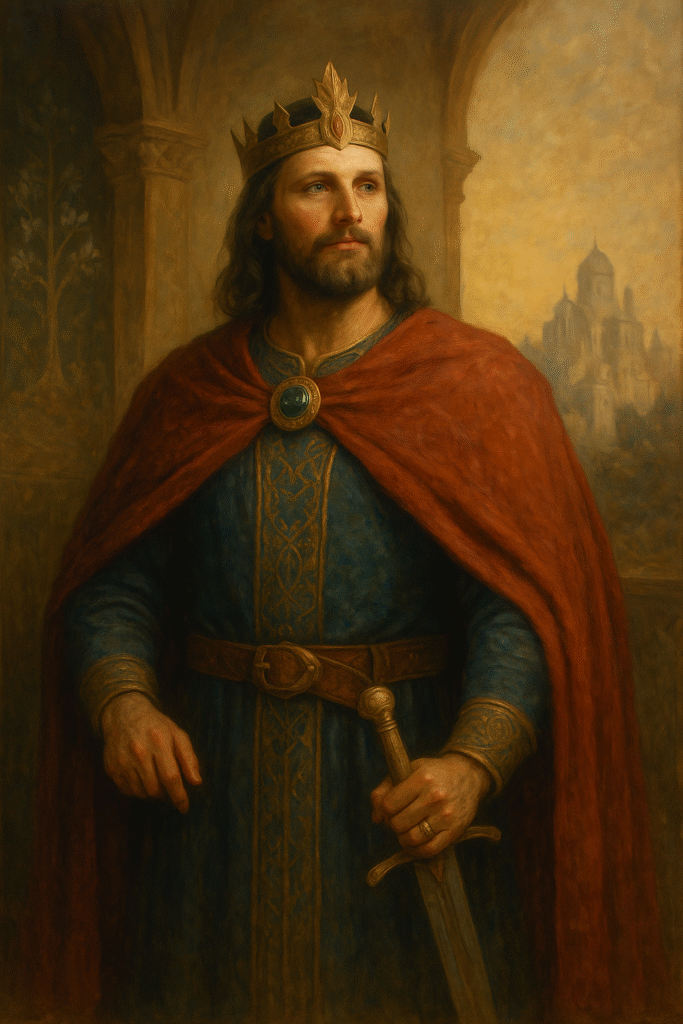Strider to High King: Aragorn’s Life After Sauron’s Fall

“The hands of the king are the hands of a healer, and so shall the rightful king be known.”
— The Lord of the Rings: The Return of the King, by J.R.R. Tolkien
When the fiery chasm of Mount Doom consumed the One Ring, and the Dark Lord Sauron’s malice at last dissolved into smoke and ruin, a great silence fell upon Middle-earth. For an age of men and elves alike, the Shadow had stretched over the world. Now, with a single act of courage and sacrifice, that shadow was broken. The towers of Barad-dûr collapsed into ash, the Nazgûl were swept away in shrieking winds, and the free peoples found themselves standing upon the threshold of a new dawn.
Among them was a man who had long walked in obscurity, cloaked in the guise of a Ranger. Known to many only as Strider, he was the last descendant of a line that had endured three thousand years of hardship and wandering since the fall of Númenor. This was Aragorn son of Arathorn, heir of Isildur, and it was to him that fate and long memory had entrusted the renewal of kingship.
Thus began the reign of King Elessar, the Elfstone: healer, warrior, and sovereign of the Reunited Kingdom. His story after the War of the Ring is not only the tale of a crown reclaimed, but of an age reborn—a time of mercy, justice, and the forging of hope from the ruins of despair.
The Crown of Elendil Restored
The coronation of Aragorn was more than a ceremonial act; it was the healing of a rift that had stretched across centuries. After the death of Isildur, Gondor and Arnor—the twin realms of Elendil’s sons—had fallen into division. Gondor endured, though battered by war and plague. Arnor, however, was eventually shattered by the Witch-king of Angmar, its people dwindling into a remnant known only as the Rangers of the North.
Thus Aragorn’s ascension was the first time in three thousand years that the two thrones were united. He did not rise as the mere thirty-fifth King of Gondor, nor as the twenty-sixth Chieftain of the Drúedain, but as the first High King of the Reunited Kingdom.
At his breast gleamed the Elfstone of Galadriel, gifted to him long before in Lothlórien as a token of destiny:
“This stone I gave to Celebrían my daughter, and she to hers; and now it comes to you as a token of hope. Take the name that was foretold for you, Elessar, the Elfstone of the house of Elendil.”【LotR: The Fellowship of the Ring, II.8】
From that moment, Aragorn was no longer Strider the wanderer. He stood tall and kingly, crowned with the silver circlet of Gondor, robed in white, and bearing the sword reforged, Andúril, Flame of the West, at his side.

The King as Healer and Judge
Aragorn’s reign was marked from the very beginning by a truth foretold in Gondor’s prophecies: “The hands of the king are the hands of a healer.” When Minas Tirith was still reeling from the Siege, it was Aragorn—not yet crowned—who entered the Houses of Healing and brought Faramir, Éowyn, and Merry back from the shadow of the Black Breath. With athelas in his hands and words of hope on his lips, he revealed himself as the long-awaited king.
This healing power was not limited to the body. It extended to law, mercy, and governance. When Beregond of the Guard was brought before him for forsaking his post and shedding blood in the sacred halls in order to save Faramir, Aragorn faced a test of judgment. The ancient law demanded death. But the King looked deeper than law and saw loyalty:
“All penalty is remitted, because all that you did was for the love of the Lord Faramir. Nonetheless, you must leave the guard of the Citadel … Yet you are appointed Captain of the White Company, and you shall dwell in Emyn Arnen in honor and peace.”【LotR: The Return of the King, VI.5】
In this act, the people of Gondor saw the justice of a ruler who understood that mercy, wisely given, strengthens a kingdom more than fear.
Friendships, Oaths, and the Binding of Nations
No king rules alone, and Aragorn was ever mindful of the bonds that held the Free Peoples together. The Oath of Eorl—sworn centuries earlier between Gondor and Rohan—was renewed in the days of his reign. Side by side with Éomer, the new King of Rohan, Aragorn pledged their friendship anew:
“Their enemies shall be our enemies, their need shall be our need; and whatsoever evil may come upon them, we will aid them to the utmost end of our strength.”【LotR: Appendix A, “The House of Eorl”】
But his alliances extended further. To the Ents, he gifted the valley of Nan Curunír, once defiled by Saruman, saying:
“I will give to the Ents all this valley, to do with as they will, so long as they keep a watch upon Orthanc and see that none enter it without my leave.”【LotR: The Return of the King, VI.6】
To the Dúnedain, persecuted since the First Age, he granted freedom in their forest. And to the Hobbits—his steadfast companions—he gave the greatest gift of all: freedom from the burdens of the wider world. By royal decree, the Shire was made inviolate:
“The Shire shall be preserved, and the Big People shall never again enter its borders.”【LotR: Appendix B】
Thus Aragorn proved himself not merely Gondor’s sovereign, but the protector of all free folk, great and small.
Wars in the Shadows, Peace in the Light
Though Sauron had been cast down, evil is never wholly vanquished. In the East and South, unrest simmered, and warbands lingered in hatred of Gondor. Aragorn rode once more to battle, with Éomer beside him, leading hosts across distant plains until the realm stood secure.
And yet, these campaigns did not overshadow his reign. They were the remnants of a long struggle, not the shape of the new age. In Minas Tirith, the White Tree—long barren—flowered anew. Gandalf himself had revealed the sapling upon Mindolluin’s slopes:
“Verily, this is a sapling of the line of Nimloth the fair… Here it has lain hidden, even as the race of Elendil lay hidden in the wastes of the North. Yet the line is not ended.”【LotR: The Return of the King, VI.5】
With its blossoming, the people knew that Gondor was truly renewed.
The Evenstar of His Heart
Above all his victories and decrees, there was Arwen Undómiel. Their love was the culmination of a tale woven across ages, echoing the fates of Lúthien and Beren. On Midsummer’s Day, in the court of the White Tree, they were wed, and the realms rejoiced. Frodo, watching her arrival, understood why the King had asked the Fellowship to remain in Gondor until that day:
“‘At last I understand why we have waited,’ he said to Gandalf. ‘This is the ending. Not day only shall be beloved, but night too shall be beautiful and blessed.’”【LotR: The Return of the King, VI.5】
But the price of such love was mortality. At 210 years of age, Aragorn laid down his life willingly, as was the gift of the Númenóreans. To Arwen, his parting words were tender yet unyielding:
“To me has been given the grace to go at my will and give back the gift. Now therefore I will sleep.”【LotR: Appendix A】
Arwen, stricken with grief, departed from Minas Tirith. She journeyed north to Cerin Amroth, where once she had pledged herself to Aragorn beneath the golden leaves of Lórien. There she lay herself down in silence, her light fading with the waning of her people.
The Legacy of the Elfstone
Aragorn’s line endured through his son, Eldarion, who inherited the throne of the Reunited Kingdom. The house he founded bore the name Telcontar—Strider in the tongue of Gondor—a tribute to the long road that had led him from exile to kingship.
Through his reign, Middle-earth passed into the Fourth Age, the Age of Men. The Elves departed, the Dwarves dwindled, and the Hobbits faded into the quiet corners of legend. Yet in every hall where songs were sung—in Minas Tirith, in Edoras, and in the green hills of the Shire—the name of King Elessar endured.
In Aragorn’s story after the War of the Ring, we glimpse not just the fate of a king, but the healing of an age—the promise that even in the shadow of sorrow, hope may bloom anew.
Bibliography
- J.R.R. Tolkien, The Lord of the Rings: The Fellowship of the Ring, Book II, Chapter 8.
- J.R.R. Tolkien, The Lord of the Rings: The Return of the King, Book VI, Chapters 5–6.
- J.R.R. Tolkien, The Lord of the Rings: Appendix A – The Tale of Aragorn and Arwen.
- J.R.R. Tolkien, The Lord of the Rings: Appendix B – The Tale of Years.
Related Links:
- The Hidden Authors of Middle-earth: Tolkien’s Greatest Literary Illusion
- The Many Faces of Sauron: Understanding the Dark Lord’s Ten Forms in Middle-Earth
👁️ 160 views

